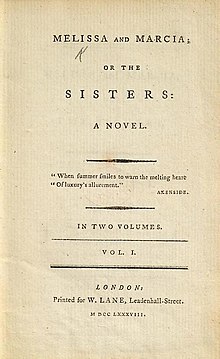Elizabeth Hervey (writer)
Elizabeth Hervey | |
|---|---|
| Born | Elizabeth March 1748 |
| Died | 1820 (aged 71–72) |
| Occupation | writer |
| Language | English |
| Years active | 1788–1814 |
| Spouse | Alexander Harvie; William Thomas Hervey |
| Relatives | William Beckford (brother) |
Elizabeth Hervey (1748–1820) was the author of seven novels, six of which were published and one of which exists "in a carefully-bound manuscript."[1]

Life[edit]
Elizabeth March was the daughter of Maria Hamilton (7 January 1725 – 22 July 1798), daughter of George Hamilton (MP for Wells) and granddaughter of the sixth earl of Abercorn, and Francis March, a "Jamaican planter and City man."[2] After the death of her father, her mother married wealthy planter, slave-owner and politician William Beckford.[3] While still in her teens, March married Alexander Harvie, a business associate of her stepfather's who died in 1765 and left her a widow at the age of seventeen.[4] Her second marriage was also brief: in 1774 she married Col William Thomas Hervey and had two sons before Hervey either died or the marriage ended in 1778, while the family was living abroad due to debt.[5] In 1789, Hervey was reported to have been living in Brussels and having an affair with poet and radical Robert Merry, with whom she apparently maintained a friendly relationship after they parted.[1] Merry was a leading force in the Della Cruscan literary movement who came in for considerable criticism for their literary mannerisms.
Hervey was the elder half-sister of wealthy art collector and writer William Beckford. The siblings corresponded when young, but would seem to have been less close when older: in 1797 Beckford published a "marked burlesque attack on women's writing": Azemia: A Descriptive and Sentimental Novel. Interspersed with Pieces of Poetry.[1] Azemia satirized women authors of sentimental novels including Mary Champion de Crespigny, Susannah Gunning, Hannah More, Mary Robinson — also associated with the Della Cruscans — and Hervey herself. The incident apparently caused her "much upset," though modern commentators tend to agree that Hervey is less deserving of the criticism than some of Beckford's other targets.[5]
Work[edit]
Hervey's first five novels were all published anonymously, which has at times led to difficulties for bibliographers: her second novel, Louisa (1790) has been erroneously attributed to Jane West.[3] Her third novel, The history of Ned Evans (1796), is a fictional captivity narrative which also treats the Irish nationalist movement.[1] Her final novel, Amabel; or, Memoirs of A Woman of Fashion (1814), her only work to debut under her own name, was dedicated to the queen.[5]
Her novels went into multiple editions and at least four of them were translated into French: The history of Ned Evans,[6] The church of St. Siffrid,[7] The Mourtray Family,[8] and Amabel.[7] Hervey's publishing career was book-ended by the Minerva Press: both her first novel, and the second edition of her sixth and final novel, were published by that well-known company.[9]
Hervey was one of the 106 "lost" women writers Dale Spender listed in Mothers of the Novel in 1986.
Novels[edit]
- Melissa and Marcia; or the sisters: a novel. In two volumes. London: William Lane, 1788; 2nd ed. 1796.
- Louisa. A novel, in three volumes. By the author of Melissa and Marcia; or, the sisters. London: Thomas Hookham, 1790. (Irish edition: Dublin: Wogan et al., 1790).
- The history of Ned Evans. In four volumes. London: G. G. and J. Robinson, 1796; 2nd ed. 1797. (Irish eds.: Dublin, 1796; 1797.)
- The church of St. Siffrid. In four volumes. London: G. G. and J. Robinson, 1797. (Irish ed.: Dublin: William Porter and Nicholas Kelly, 1798)
- The Mourtray Family. A novel. In four volumes. London: R. Faulder, 1800. (2nd ed.: 1810; 3rd ed.: London: Henry Colburn, 1814)
- Amabel; or, Memoirs of A Woman of Fashion. By Mrs. Hervey. Author of the Mourtray Family, &c. In Four Volumes. London: Henry Colburn, 1814. (2nd ed.: London: A. K. Newman and Co., 1818)
Etexts[edit]
- The Mourtray Family. 1800. (Full text, HathiTrust) (Google Books: Full text, 3rd ed. 1814, Vol. I, II, III, IV)
- Amabel; or, Memoirs of a woman of fashion. 1814. (Full text, HathiTrust)
Notes and references[edit]
Notes[edit]
- ^ a b c d Brown et al.
- ^ McConnell, ODNB.
- ^ a b Todd, p. 163.
- ^ "Elizabeth Hervey (1748–1820)," Library Thing.
- ^ a b c Blain et al., p. 517.
- ^ Histoire de Ned Evans, Internet Archive, Accessed 26 Oct. 2022.
- ^ a b VIAF
- ^ La Famille de Mourtray, Internet Archive, Accessed 26 Oct. 2022.
- ^ Montague Summers, A Gothic Bibliography (1941; available online at Internet Archive)
References[edit]
- Blain, Virginia, et al., eds. "Hervey, Elizabeth." The Feminist Companion to Literature in English. New Haven and London: Yale UP, 1990, p. 517. (Open access, Internet Archive)
- Brown, Susan, Patricia Clements, and Isobel Grundy. "Elizabeth Hervey." Orlando: Women’s Writing in the British Isles from the Beginnings to the Present. Ed. Susan Brown, Cambridge University Press. Cambridge UP, n.d. 22 Mar. 2013. Accessed 25 Oct. 2022.
- McConnell, Anita. "Beckford, William Thomas (1760–1844), writer and art collector." Oxford Dictionary of National Biography. 21. Oxford University Press. Accessed 26 Oct. 2022.
- Todd, Janet, ed. "Hervey, Elizabeth." A Dictionary of British and American women writers, 1660-1800. Totowa, N.J.: Rowman & Allanheld, 1985, pp. 162—163. (Open access, Internet Archive)
- "Hervey, Elizabeth." The Women's Print History Project, 2019, Person ID 201. Accessed 2022-10-25.
